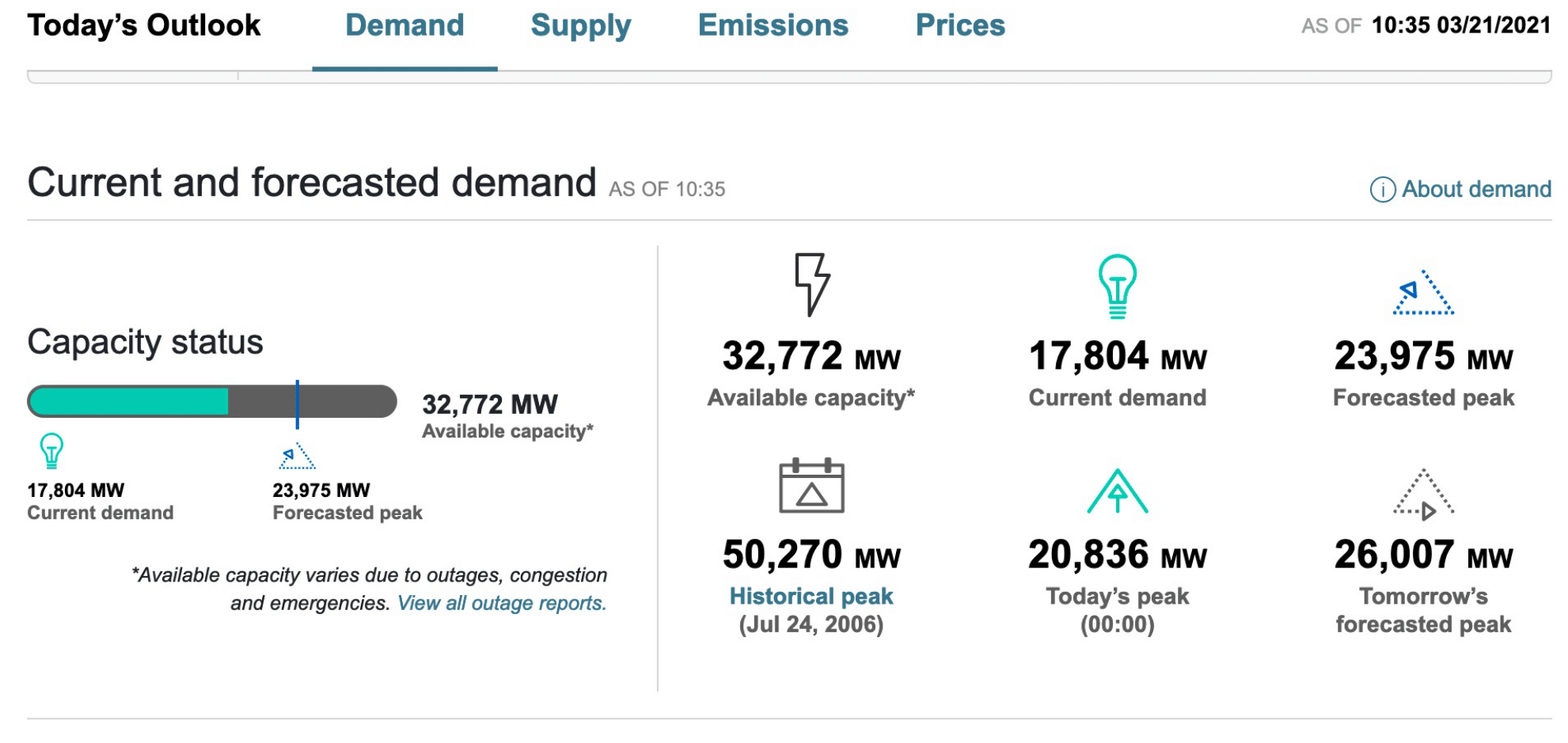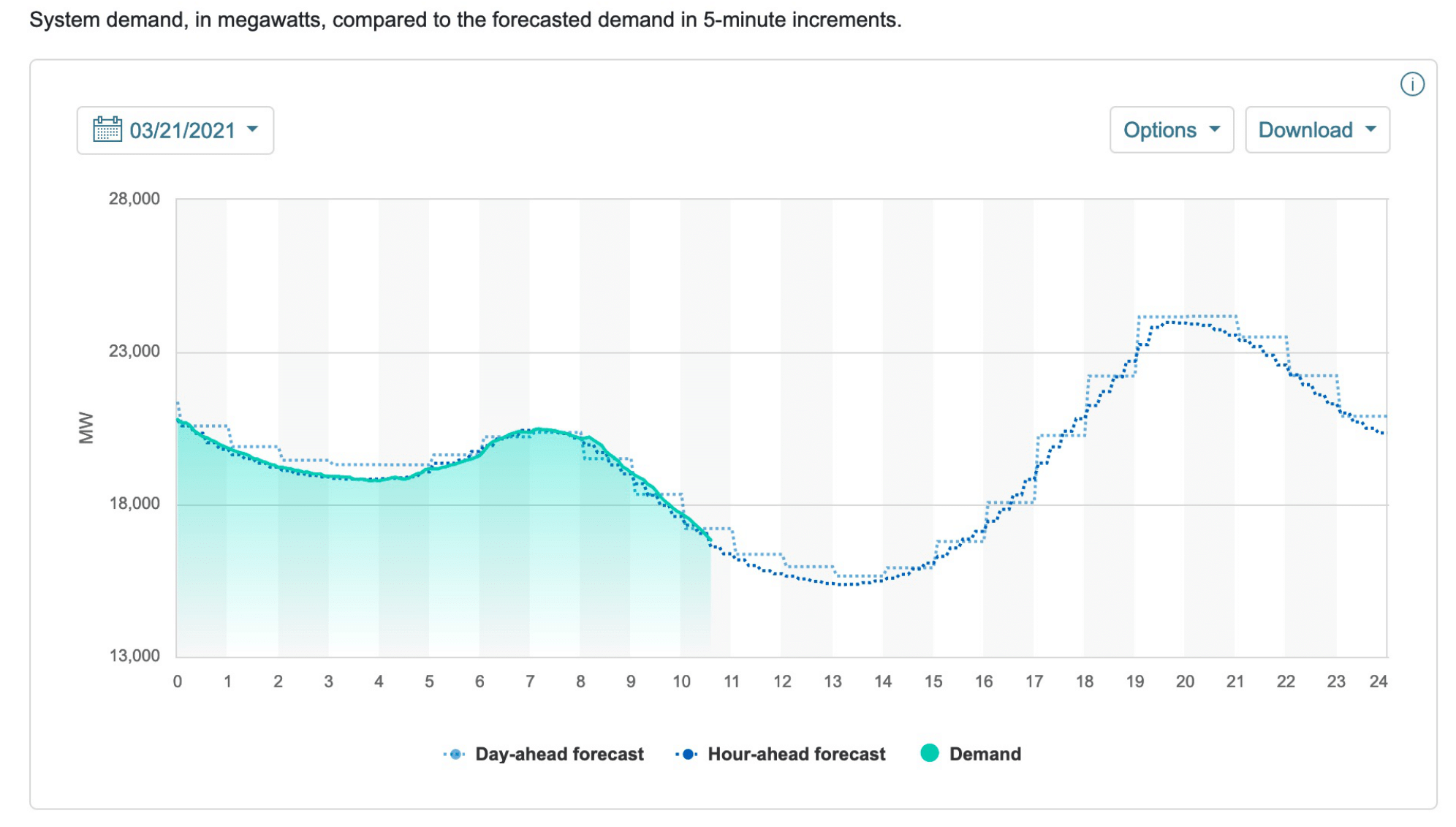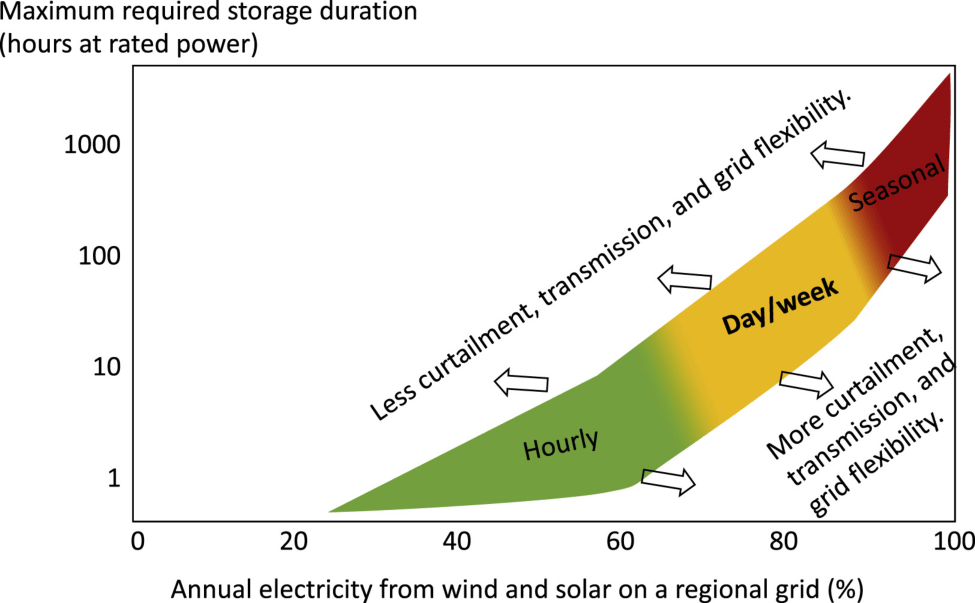Warning
-
Quoted numbers in these slides are ca 2021.
-
Current Ukraine war effects.
-
Not completely clear what future will hold
- except that renewables will become more and more competitive!
Why Electricity?
-
Clean!
-
High-quality
-
Jack of all Trades:
-
Fossil fuels are one-trick ponies,
-
→ perfect economics only for heat.
-
-
Already know e-tech will improve greatly.
-
No moonshots necessary but welcome.
-
PS: Read up on primary vs. nameplate power.
-
Heterogeneous
Electrons are electrons, but
-
Time and location matter
-
Noon vs 8pm
-
Nevada vs. New York
-
-
Allocation problems are tremendous:
-
uncertainty (supply and demand);
-
short-term (which plants to switch on);
-
long-term (which plants to build where);
-
how to move e around (transmission).
-
World
-
Even more heterogeneous than USA.
-
Discuss US / California first:
-
Illustrative only, and
-
good to explain basic workings.
-
It is not enough to decarbonize US!
USA Generation
| U.S. | NatGas | Coal | Wind |
|---|---|---|---|
| Power | 45\% | 20\% | 10\% |
| Energy | 40\% | 20\% | 9\% |
| U.S. | Nuclear | Hydro | Solar |
|---|---|---|---|
| Power | 10\% | 10\% | 5\% |
| Energy | 20\% | 7\% | 2\% |
Utility-Scale High Fixed Costs
-
Plants are built primarily when
-
demand grows, and/or
-
old plants age out.
-
-
US demand is mostly stable:
- US builds new plants mostly when (old coal and nuclear plants) age out.
New Plants: USA
-
For many years now, only Wind and Solar;
- will probably continue; explain below why.
-
A few new NatGas plants on East Coast.
-
32GW (out of 500GW) in dvlpmnt pipeline, though.
-
existing NatGas plants are beginning to install solar panels to save variable cost.
-
-
Very rare nuclear plant here and there (Terapower).
-
No new coal plants, few new dams, etc.
- PS: Oil is always uneconomic, except in emergency generators (and New Hampshire?). Used in 3rd world.
New Plants: World, Other
-
China, India, etc.:
-
Large new building programs.
-
Lots of new Wind and Solar plants.
-
Some nuclear plants, some others.
-
But huge coal plant building programs:
-
270 GW in China
-
And new world record in 2021;
- And coal employs millions of people!
-
-
Transmission Grid
-
Transmission grid is expensive.
- Think $1-$50/MWh.
-
Distance matters!
-
→ Supply is cheaper close to demand.
-
Low current transmission cost only because of generation proximity.
USA Transmission Mess
-
Complex regulation, tying in, etc.:
-
Regulators “captured” by > 3,000 utility companies,
-
with some good reason,
-
and a lot of lobbyists and lawyers,
-
and big hurdles for competitive clean engineering innovators inexperienced in politics.
-
and NIMBY
-
Electricity Allocation Problems
-
Complex problems abound.
-
Only known good allocation system:
Competitive but Managed Electricity Markets!
Electricity Allocation Problems
-
But free market must be shepherded!
-
alternative free-for-all cannot work either;
-
needs regulation, but is still somewhat manipulatable and indeed manipulated.
-
-
Compromises between scylla and charybdis.
California
-
Details are fascinating stuff.
- They are important, but vary by place
-
In California (not elsewhere):
-
Capacity auctions for new plants (3 years);
-
Power auctions for delivery (daily).
-
California: Mar 21, 2021

California: Mar 21, 2021

Today
https://www.caiso.com/todaysoutlook/Pages/index.html
California Power Mix, Mar 21, 2021

USA Power Mix

Today
https://www.caiso.com/todaysoutlook/Pages/supply.html
Add Pricing Info in 2021

Today (2023, Much Higher!)
https://www.caiso.com/todaysoutlook/Pages/prices.html
Inexact Classification
-
Baseload Power.
- Think Nuclear.
-
Intermittent Power.
- Think Wind and Solar.
-
Storage (Dispatchable Power).
- Think Batteries and Hydroelectric Dams.
Power Mix Comparison
| Nuke | GeoT | Coal | Gas | |
|---|---|---|---|---|
| Calif | 9\% | 5\% | 3\% | 34\% |
| USA | 20\% | 1\% | 19\% | 40\% |
| World | 10\% | 0\% | 37\% | 24\% |
| Hydro | Wind | Solar | Other | |
|---|---|---|---|---|
| Calif | 18\% | 10\% | 12\% | 9\% |
| USA | 7\% | 9\% | 2\% | 2\% |
| World | 16\% | 5\% | 3\% | 5\% |
Generation Costs: Building Plants
-
Electricity’s biggest cost is typically upfront plant building cost:
-
Construction / capital.
-
Plant scalability varies:
-
biggest scale needed for nuclear,
-
most flexible scale for Wind and Solar.
-
-
Cost of grid tie-in is high, too,
-
incl. regulatory costs,
-
… and does not scale linearly.
-
-
Generation Costs: Running
-
Idle (Standby) Minimum Running Cost:
- capital interest costs;
- personnel and maintenance;
- obsolescence.
-
Active Generation Cost:
-
Fuel and Extra Wear:
- Highest for Fossil fuels;
- Medium for Nuclear;
- Lowest for Wind and Solar.
-
Levelized Cost Of Electricity (LCOE)
-
Tries to take all costs into account.
-
Projected over lifetime of plant:
-
disagreement over lifetime → different LCOEs.
-
If you got it wrong, …
-
… you may lose a lot of money.
-
Following are ballpark inflation-adjusted figures, differ by location, regulation, etc.
Ballpark LCOEs Per MWh
| Type | Today | est 2050 |
|---|---|---|
| Solar Panels, Roof | $100 | $30 |
| Solar Panels, Utility | $35 | $15 |
| Wind, onshore | $35 | $20 |
| Geothermal | $35 | |
| Nuclear | $70 | $60 |
| Gas, Always On | $40 | $45 |
| Coal | $75 | $65 |
| Hydro | $55 | |
| Gas, Dispatch | $200 |
Really? Wowee!
-
Wind and Solar are the cheapest large-scale sources of energy that civilization has ever seen!
-
… and they will become even cheaper!
-
Unbelievably cheap, too cheap to meter!
$\approx$ computers
-
… but they do not always work. ☹️
-
Solved Problem!
-
“Clean intermittent generation for cheap” is a basically a solved science problem:
-
$15/MWh or $5/MWh is relatively unimportant.
-
The silicon solar cell component will soon be negligible part of solar plant cost.
-
Costs will be primarily connections / running / maintenance.
-
Often best to colocate Solar, Wind, Batteries to share connection and operation costs.
-
Natural Gas
-
NatGas is cheapest on-demand source of power in the USA:
-
Turn off, turn on.
-
Nearly infinite capacity,
-
but not as abundant everywhere else.
-
-
$40-$200/MWh — cheap, tough to beat.
-
on demand: $80-
-
Maybe should add $20/MWh for pollution.
-
NatGas often leaks on pipes and at EOL.
-
Makes NatGas look cleaner than it is.
-
-
Geothermal And Hydro (Storage)
-
Think $100-$250/MWh
-
Requires large scale:
-
Environmental opposition to hydro.
-
PS: small-scale geothermal works well for home heating cooling and is economical!
-
-
Cheap running cost.
- No fuel required.
-
Very limited supply of good locations
PS: Also consider compressed air in caverns.
Nuclear Power (Again)
-
Primary nuclear problem today:
-
Fixed cost ($20 billion/plant).
-
10 years: potentially obsolete before open.
-
-
Honest Disagreements:
-
Put your money where your mouth is?
-
Gates, France, China are bullish.
-
UnionCScientists, Germany are bearish.
-
Coal: USA
-
Hated and obsolete.
-
But kept alive by:
-
Abundant availability and e-needs now.
-
Fossil fuel subsidies and lobbies.
-
Large employment bases, pivotal voters.
-
Still, fortunately, plants are aging out now,
- Unfortunately, just like clean nuclear plants.
-
-
USA, 250 plants + 0 uc (construction)
Coal: Think Global
-
Coal is still hated and obsolete.
-
But growing countries need power now.
-
Coal consumption and coal plants set new records in 2021!
- Long-term, coal faces likely stagnation, not immediate obsolescence.
Coal: Think Global
-
The World’s Real Problem:
-
China, 1000 + 200uc .
-
India, 250 + 50uc .
-
World, 2,000 + 500uc .
-
-
Once built, sunk-cost equation changes:
-
30-50-year lasting impact!!
-
Any good ideas? Now is the time!
-
Dispatchable (Storage)
-
If demand is reasonably constant, choose
-
either basepower;
-
or intermittent + storage;
-
basepower + storage is not so great.
-
Simplified
-
Power connection infrastructure is expensive,
-
more so for intermittent power.
-
Optimal solutions are often messy mixes.
-
One size ``no fit all.’’
Clean Energy
In sum:
Problem is No Longer Cheap Generation!
Problem Now is Cheap Energy Storage!
Solve it, and wind/solar will take over.
Lithium Batteries
-
Think $200/MWh.
-
Li comes in small manufactured cells.
-
Cells are finicky and small.
-
Not easily scalable:
-
Expensive packaging into small cells.
-
Twice the capacity is approx twice the cost.
-
Lots of mundane improvements, but
-
will likely always be finicky small-scale.
-
Current Big Lithium Problem
-
Problem: Wear out after 1,000 cycles.
-
Anode and cathode expand and contract.
-
But very soon 3,000 - 5,000 cycles!
-
→ Much cheaper for long-run use.
-
→ Very big deal for utility-scale storage.
- Could bring price down to $100/MWh?
-
→ Use your EV car for storage?
-
PS: No scientific reason why not 50,000 cycles, either.
-
Utility-Scale Lithium In USA
-
2 GW power out of 450 GW total.
-
10 GWh energy out of 4,000,000 GWh.
-
Problem is capacity, not power.
-
Batteries rapidly expanding, but still tiny:
-
Many specialty uses (e.g. 6-10pm).
-
Still too expensive for overnight,
-
…much less for multi-day storage.
-
Net Zero?

Flow And Other Batteries
World Need:
-
Giant house-sized tubs with person-sized electrodes that scale according to whim,
-
with quad storage → only double cost,
-
with cheap chemistries, $50/MWh,
-
and then it will be lights-out for most power plants other than wind and solar in 20-30 years!
-
at $150/MWh, we could make it to 95%!
Utility-Scale Flow Batteries
-
Possible, even likely.
-
But not here yet.
-
Better to spend lots of $$$s now on research and development than on deployment now.
-
I am optimistic. (10 years?)
-
-
But what if I am overoptimistic?
- This is not a solved problem!
Hydro-Electric Power
-
Think $250/MWh.
-
Categories: Flow, Dammed, Pumped.
-
Limited Potential (but still 2x today’s).
-
High capacity, lower efficiency than batteries:
-
Still cheaper for big energy needs.
-
Here now and can supply 8-12 hours!
-
Some even multi-day (Hoover).
-
Hydro-Power Problem
-
Few suitable locations.
-
Large scale only.
-
Extremely high upfront fixed cost.
-
What if battery power becomes cheaper more quickly than expected?
Unconventional Solutions
- Trains schlepping weights up a hill?!
-
Maybe not crazy at all?:
-
Maybe $100-$200/MWh ?
-
Perhaps not great long-run solutions,
-
but temporarily not uncompetitive either (for now)?
-
Cranes Stacking Blocks

Longer-Term Storage
-
Polar vortex-like wind/solar outages?!
-
Seasonal elec-storage?
-
Long-term elec-storage needs higher capacity at very low scaling cost, but lossier is ok.
-
Underground heat reservoirs?
-
Underground compressed air reservoirs?
-
Hydrogen?? (not as battery substitute!)
-
Heat Use Of Stored Electricity?
-
Seems always like a bad idea.
-
Ignore talking heads
-
OK, may take a little bit to reliably go to industrial high heat, 2200C.
-
-
IMHO, don’t store electricity for heat later.
-
Instead store heat in insulated containers.
-
Heat storage can work on any scale:
- Houses, factories, or cities.
Energy Transmission Grid
-
Wind is always somewhere. Yet:
-
Grid transmission lines are expensive.
-
Transmission is lossy over long distance.
- Significant variable cost ($1-$50/MWh).
-
Transmission has other issues:
-
Power line breaks,
-
causing fires,
-
or even cyber attacks.
-
-
Transmission
-
Very complex engineering and political problems:
-
It evolved naturally for local industrial needs.
-
Total regulatory mess in USA now.
-
-
Needs to allow more intermittent energy:
-
Intermittent adds potential wires overload.
-
→ Sometimes prices turn negative!
-
Even in California, often in Germany.
-
Key Clean Energy Problem Now
- Storage, Storage, Storage
Secondarily, transmission grid
Feasibility/cost remain location-specific and complex.
Irony?
-
Solar energy will cost $15/MWh. Wow!
-
If we could store and release for another $15/MWh (heck, $50/MWh),
-
we could built 200+ GWh of storage,
-
plus electrify most fossil-fuel uses,
-
and it would be lights out for fossil fuels (for 2/3 of uses)!
-
-
But storage costs ca 2020 more like $200/MWh.
- Maybe $100/MWh in 10 years with some luck.
Not Covered
-
Reliability is hugely important.
-
When electricity goes out, the world stops.
-
All industry and jobs depend on it.
-
-
Inefficient to have too many decentralized backup generators everywhere.
-
Lebanon or South Africa today.
-
France and Germany barely escaped in 2022-2023.
-
Energy Provision 2015, TWh
| Coal | NatGas | Nuke | Hydro | |
|---|---|---|---|---|
| USA | 1,410 | 1,317 | 797 | 249 |
| China | 3,860 | 148 | 161 | 1,103 |
| World | 9,621 | 5,585 | 2,440 | 3,843 |
| Wind | Solar | (Oth) | Total | |
|---|---|---|---|---|
| USA | 191 | 39 | (2.2\%) | 4,092 |
| China | 186 | 45 | (1.1\%) | 5,562 |
| World | 828 | 263 | (2.6\%) | 23,171 |
Energy Forecast 2050, Twh
| Coal | NatGas | Nuke | Hydro | |
|---|---|---|---|---|
| USA | 593 | 1,953 | 594 | 294 |
| China | 3,556 | 803 | 1,002 | 1,448 |
| World | 8,115 | 7,306 | 3,025 | 5,548 |
| Wind | Solar | (Oth) | Total | |
|---|---|---|---|---|
| USA | 790 | 1,071 | (3.0\%) | 5,458 |
| China | 1,001 | 3,379 | (0.4\%) | 11,230 |
| World | 6,833 | 10,152 | (2.3\%) | 41,953 |
Electricity Conclusion
-
Generation is basically a solved problem.
-
Storage is the unsolved problem.
-
Wish nuclear plants were a lesser conundrum.
-
NatGas is economic challenge for c.e.
- Wish we had a reasonable fossil-fuel tax!
-
Coal plants outside OECD remain vexing.